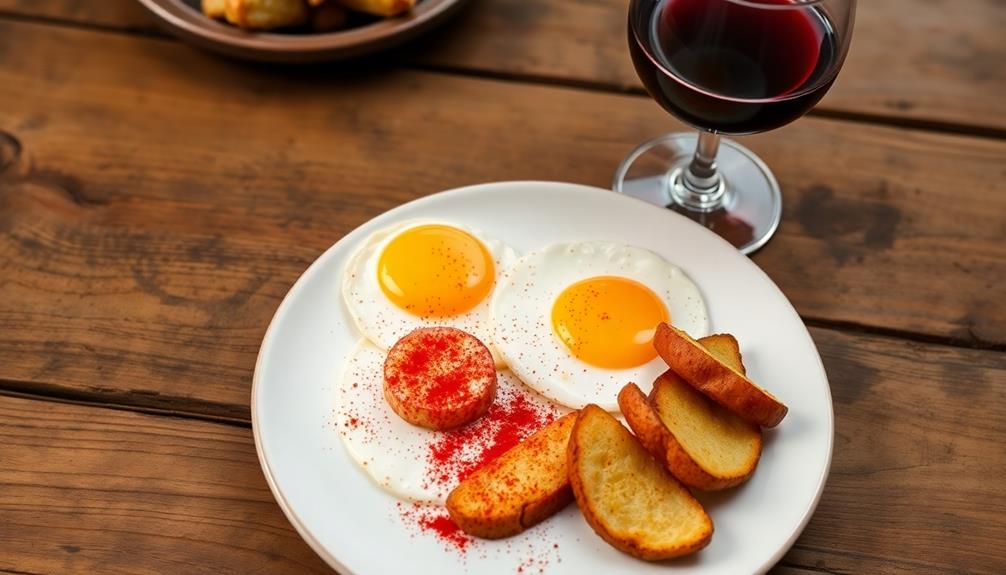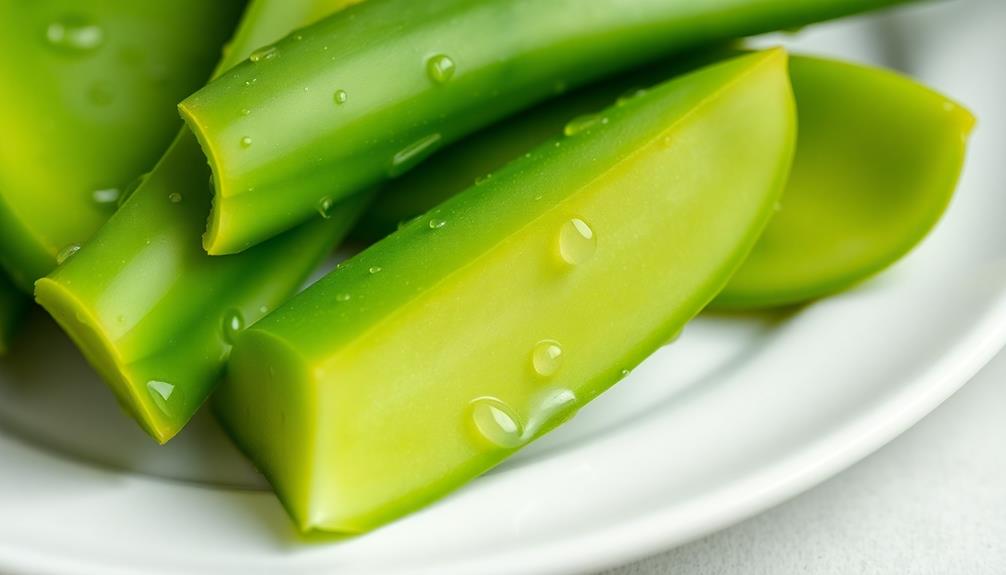Capirotada, the delectable Mexican bread pudding, is a true taste of heritage! Tracing back to colonial times, this comforting dessert blends sweet and savory flavors, featuring layers of toasted bread, rich syrup, juicy fruits, and crunchy nuts. It's a beloved tradition often enjoyed during Lent and special occasions, symbolizing the vibrant culinary culture of Mexico. Whether you're craving a nostalgic bite or simply seeking a new and exciting dessert, capirotada is sure to delight your senses. Warm, gooey, and topped with a scoop of creamy vanilla ice cream – this heavenly treat is a must-try for anyone looking to explore the depths of Mexican cuisine.
Key Takeaways
- Capirotada is a traditional Mexican dessert known as bread pudding, featuring layers of bread, syrup, and various toppings.
- The dish has origins tracing back to the colonial era and represents a connection to Mexican heritage and traditions.
- Key ingredients in capirotada include bread, syrup made from piloncillo, fruits like raisins and bananas, and nuts such as walnuts or pecans.
- The preparation process involves soaking bread in a milk mixture, combining it with beaten eggs, and baking the mixture until golden brown.
- Capirotada is often served warm, topped with vanilla ice cream, and can be enjoyed as a breakfast or dessert option.
History
The origins of capirotada, a beloved Mexican bread pudding, can be traced back to the colonial era, when Spanish settlers introduced their culinary traditions to the region.
As the Spanish missionaries and colonizers made their way through Mexico, they brought with them recipes and ingredients that would eventually blend with local food customs, creating delicious new dishes.
Capirotada, with its mix of bread, cheese, nuts, and sweet syrup, is the result of this cultural exchange.
Over the centuries, the recipe has evolved, with each region and family putting their own unique spin on the classic dish.
Today, capirotada is a beloved treat, enjoyed during the Lenten season and special occasions.
Its rich flavors and comforting texture have made it a cherished part of Mexican culinary heritage, a delicious link to the past and a symbol of the country's vibrant food culture.
Recipe
Capirotada is a beloved Mexican bread pudding that combines sweet and savory flavors. This traditional dish is often enjoyed during Lent, but its comforting warmth makes it a delightful treat any time of year.
The preparation of capirotada involves layering bread, cheese, nuts, and a sweet syrup, creating a harmonious balance of textures and tastes. The dish's origins can be traced back to the Spanish colonial era, when it became a staple in the Mexican culinary landscape.
Ingredients:
- 1 loaf of day-old bread, torn into bite-sized pieces
- 1 cup crumbled queso fresco or other Mexican cheese
- 1 cup raisins
- 1 cup chopped pecans
- 1 cup brown sugar
- 1 teaspoon ground cinnamon
- 1/2 teaspoon ground cloves
- 1/2 teaspoon ground allspice
- 1 cup water
- 1/2 cup unsalted butter
To Prepare:
In a large saucepan, combine the brown sugar, cinnamon, cloves, allspice, and water. Bring to a boil, then reduce heat and simmer for 10 minutes, stirring occasionally, until the mixture has thickened into a syrup. Remove from heat and stir in the butter until melted and well combined.
In a large baking dish, layer the torn bread, cheese, raisins, and pecans, pouring the warm syrup over each layer. Repeat the layering process until all ingredients are used. Cover the dish and refrigerate for at least 30 minutes, allowing the bread to soak up the flavors.
When ready to serve, preheat the oven to 375°F (190°C). Bake the capirotada for 30-40 minutes, or until the top is golden brown and the edges are crisp. Serve warm, garnished with additional cheese, raisins, or pecans, if desired.
The key to a successful capirotada is to allow the bread to thoroughly absorb the sweet syrup, creating a cohesive and flavorful dish. Experiment with different types of cheese, nuts, or dried fruits to personalize the recipe to your taste.
Cooking Steps
Soak the bread in the sweet milk mixture until it's nice and soft.
Then, combine the soaked bread with the egg and stir it all up.
Pop the mixture into a preheated oven and bake it until it's golden brown.
Step 1. Soak Bread in Milk Mixture
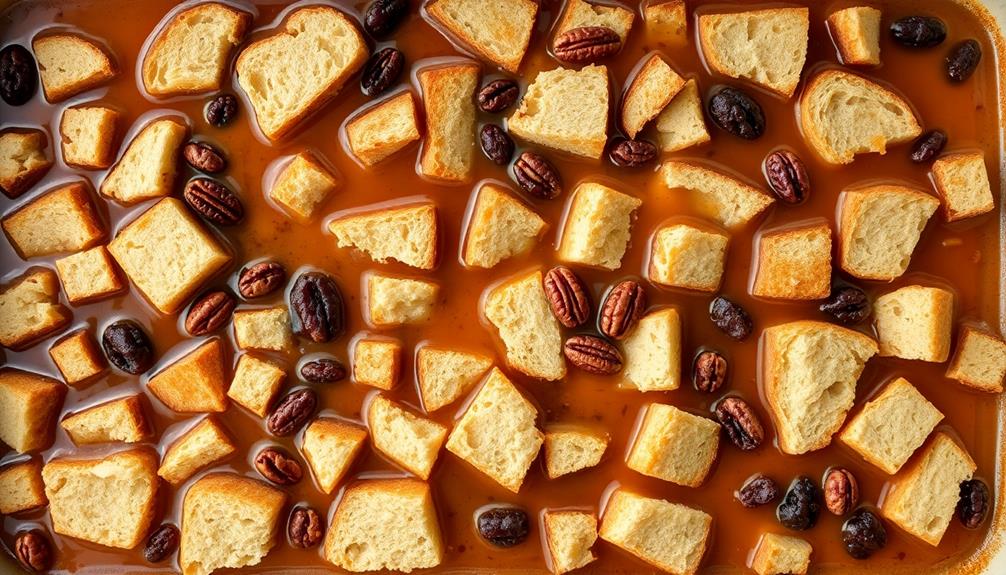
Next, you'll want to soak the bread in the milk mixture. Grab those slices of bread and gently place them into the bowl, making sure they're fully submerged.
The bread will start to soak up all that delicious, creamy goodness. You can even use your hands to lightly press down on the bread, helping it absorb the milk even faster.
As the bread soaks, you'll notice it starts to soften and transform into a beautiful, pillowy texture. This step is crucial for creating the perfect, melt-in-your-mouth capirotada.
Take your time and let the bread soak for about 10 minutes, or until it's reached your desired consistency. Once it's ready, you can gently remove the bread from the milk mixture, being careful not to tear it.
Now you're one step closer to enjoying this classic, comforting dessert!
Step 2. Combine Bread Mixture and Egg
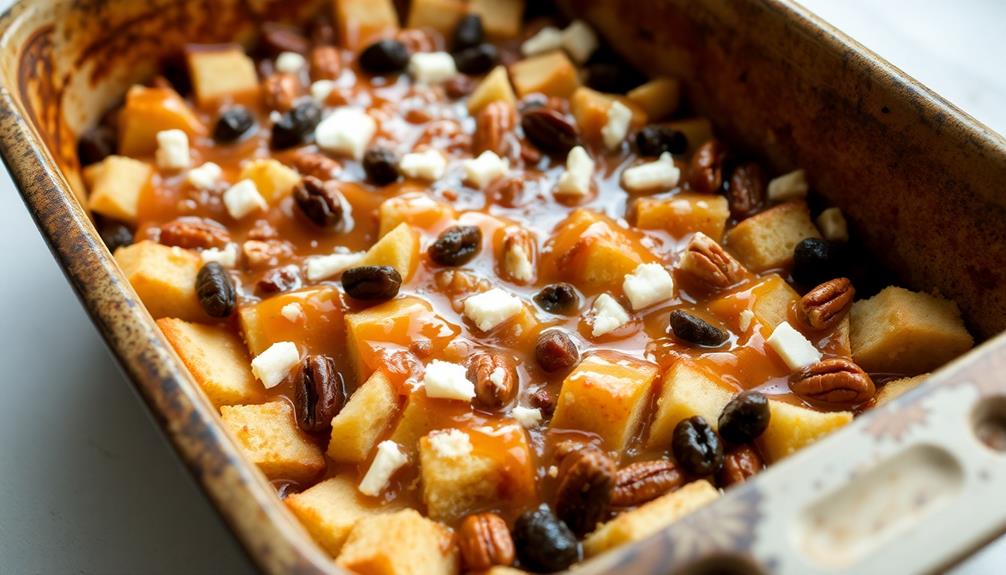
With the bread now soaked, it's time to combine it with the beaten eggs. Grab a large mixing bowl and gently transfer the softened bread into it.
You'll want to use your hands to break up any big chunks, so the bread is in nice, bite-sized pieces.
Next, pour in the beaten eggs and use a sturdy spoon or fork to fold everything together. Mix it all up until the bread is completely coated and the whole mixture looks nice and creamy.
Be sure to scrape the sides of the bowl to get every last bit incorporated.
Now, doesn't that look and smell absolutely heavenly? The rich, custardy texture from the eggs is going to make this bread pudding extra special.
Get ready, because the next step is pouring this delightful mixture into a baking dish. Your kitchen is about to be filled with the most mouthwatering aroma!
Step 3. Bake in Preheated Oven
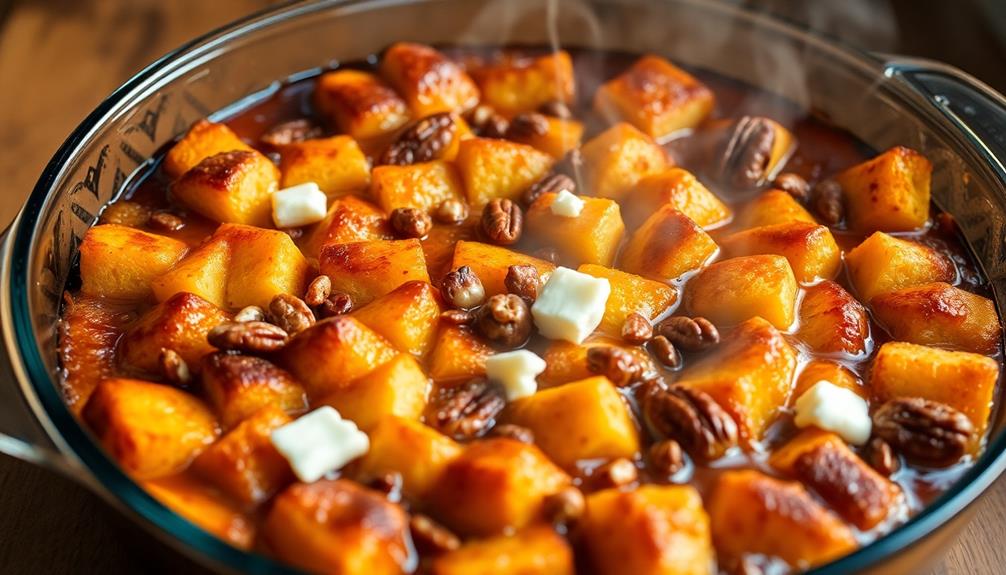
Preheat your oven to 350°F.
You're almost done! Get ready to bake your capirotada, also known as Mexican bread pudding. This is the best part where the flavors all come together.
Grab an oven-safe baking dish and carefully pour the bread mixture into it. Make sure to spread it out evenly so it bakes up nice and fluffy.
Now, pop that dish right into the preheated oven. Set a timer for 45 minutes and let the magic happen! The house will start smelling amazing as the capirotada bakes.
You'll know it's ready when the top is golden brown and a toothpick inserted in the center comes out clean.
Remove the dish from the oven using oven mitts – it's hot! Let the capirotada cool for 10 minutes before diving in.
Mmm, the sweet cinnamon aroma is so inviting. Get ready to enjoy a warm, comforting slice of this delicious Mexican dessert.
Step 4. Sprinkle Cinnamon and Sugar on Top
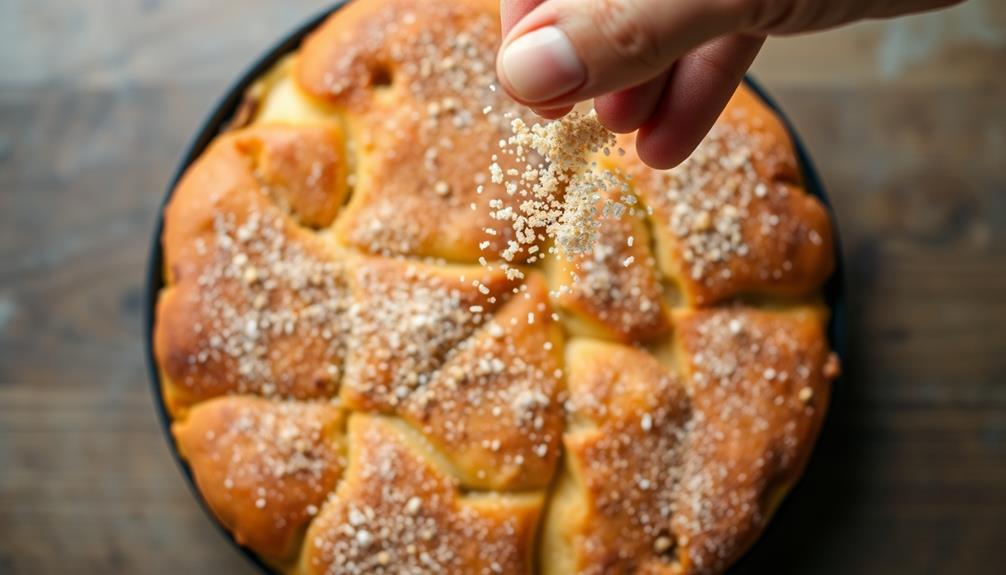
Once the capirotada has baked to perfection, it's time to add the finishing touch. Grab your trusty shaker and give it a good shake – it's time to sprinkle on the cinnamon and sugar! The sweet aroma will start to fill the air, making your mouth water.
Slowly and evenly, dust the top of the warm, golden-brown bread pudding with the cinnamon-sugar mixture. Watch as the spices settle into all the nooks and crannies, creating a delightful crunchy topping. As you cut into the pudding, the creamy, custardy interior oozes out, perfectly complementing the crunch of the topping. This classic dessert has been a staple of British cuisine for centuries, and its warm, comforting flavors and textures have made it an iconic British dish. Whether enjoyed with a dollop of vanilla ice cream or a drizzle of warm caramel sauce, bread pudding is a timeless treat that evokes feelings of nostalgia and satisfaction.
Don't be shy – be generous with the cinnamon and sugar! You want every bite to be bursting with that classic capirotada flavor. Once you've coated the entire surface, take a step back and admire your handiwork.
The capirotada is now ready to serve, with its crisp, cinnamony crust and soft, custardy interior. Get ready for the oohs and aahs when you bring this masterpiece to the table!
Step 5. Serve Warm With Vanilla Ice Cream
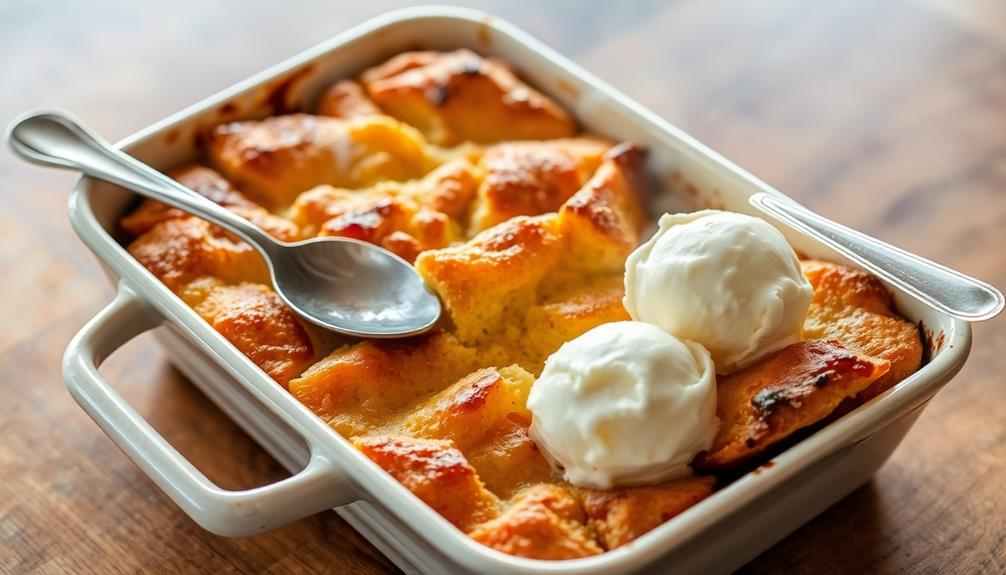
Now that the capirotada is perfectly dusted with cinnamon and sugar, it's time to serve this delightful dish.
Grab a warm, steaming slice and top it with a generous scoop of creamy vanilla ice cream. The contrast of the hot, sweet bread pudding and the cool, silky ice cream is simply irresistible.
The cinnamon and sugar mixture adds a lovely crunch, while the ice cream melts into the capirotada, creating a heavenly blend of flavors and textures. Don't forget to grab a spoon – you'll want to savor every last bite!
The warm, comforting aroma of the capirotada will fill the air, making your mouth water. Serve this dish warm, and watch as your family and friends' faces light up with joy.
The capirotada is best enjoyed fresh, so dig in and indulge in this classic Mexican dessert.
Final Thoughts
Although capirotada may not be as well-known as some other Mexican desserts, it's a delightful treat that deserves more recognition.
The warm, comforting flavors of cinnamon, raisins, and melted cheese make this bread pudding a true delight for the senses. Imagine taking a bite, the soft, custard-like texture mingling with the crunch of toasted bread and the sweetness of the syrup.
It's a harmonious blend that's sure to please your taste buds. And don't forget the crowning glory – a scoop of cool, creamy vanilla ice cream on top, which perfectly complements the richness of the capirotada.
Whether you're enjoying it as a cozy dessert on a chilly night or as a special treat, this Mexican classic is sure to become a new family favorite.
Frequently Asked Questions
Does Capirotada Contain Any Dairy Products?
Yes, capirotada typically contains dairy products. The traditional recipe often includes milk, butter, or cheese, which give the dish its rich, creamy texture. As you're considering this dish, be mindful of any dairy allergies or dietary restrictions.
Can I Use Day-Old Bread for Capirotada?
You can definitely use day-old bread for your recipe. In fact, it's a common technique that helps the bread soak up the flavors more effectively. The slightly stale texture works great in this type of dish.
How Long Does Capirotada Take to Prepare?
Preparing the dish typically takes around an hour to an hour and a half, depending on the recipe and the number of servings you're making. The process involves assembling the ingredients, baking the pudding, and allowing it to cool before serving.
Can Capirotada Be Made Ahead of Time?
Yes, you can make this dish ahead of time. The flavors will meld together, and it'll be even more delicious the next day. Just be sure to store it properly and reheat it gently before serving.
Is Capirotada Served Hot or Cold?
Typically, capirotada is served warm or at room temperature. While you can enjoy it chilled, it's often best when the flavors have had a chance to meld and the bread has absorbed the delicious syrup.

